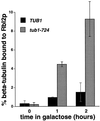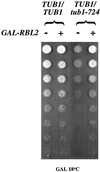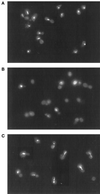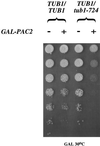An alpha-tubulin mutant destabilizes the heterodimer: phenotypic consequences and interactions with tubulin-binding proteins
- PMID: 9725898
- PMCID: PMC25501
- DOI: 10.1091/mbc.9.9.2349
An alpha-tubulin mutant destabilizes the heterodimer: phenotypic consequences and interactions with tubulin-binding proteins
Abstract
Many effectors of microtubule assembly in vitro enhance the polymerization of subunits. However, several Saccharomyces cerevisiae genes that affect cellular microtubule-dependent processes appear to act at other steps in assembly and to affect polymerization only indirectly. Here we use a mutant alpha-tubulin to probe cellular regulation of microtubule assembly. tub1-724 mutant cells arrest at low temperature with no assembled microtubules. The results of several assays reported here demonstrate that the heterodimer formed between Tub1-724p and beta-tubulin is less stable than wild-type heterodimer. The unstable heterodimer explains several conditional phenotypes conferred by the mutation. These include the lethality of tub1-724 haploid cells when the beta-tubulin-binding protein Rbl2p is either overexpressed or absent. It also explains why the TUB1/tub1-724 heterozygotes are cold sensitive for growth and why overexpression of Rbl2p rescues that conditional lethality. Both haploid and heterozygous tub1-724 cells are inviable when another microtubule effector, PAC2, is overexpressed. These effects are explained by the ability of Pac2p to bind alpha-tubulin, a complex we demonstrate directly. The results suggest that tubulin-binding proteins can participate in equilibria between the heterodimer and its components.
Figures








Similar articles
-
Structure-function relationships in yeast tubulins.Mol Biol Cell. 2000 May;11(5):1887-903. doi: 10.1091/mbc.11.5.1887. Mol Biol Cell. 2000. PMID: 10793159 Free PMC article.
-
Function of tubulin binding proteins in vivo.Genetics. 2000 Sep;156(1):69-80. doi: 10.1093/genetics/156.1.69. Genetics. 2000. PMID: 10978276 Free PMC article.
-
Suppression of a conditional mutation in alpha-tubulin by overexpression of two checkpoint genes.J Cell Sci. 1995 Mar;108 ( Pt 3):1195-204. doi: 10.1242/jcs.108.3.1195. J Cell Sci. 1995. PMID: 7622604
-
Removal of a single alpha-tubulin gene intron suppresses cell cycle arrest phenotypes of splicing factor mutations in Saccharomyces cerevisiae.Mol Cell Biol. 2002 Feb;22(3):801-15. doi: 10.1128/MCB.22.3.801-815.2002. Mol Cell Biol. 2002. PMID: 11784857 Free PMC article.
-
Natural organic compounds that affect to microtubule functions.Yakugaku Zasshi. 1998 Apr;118(4):112-26. Yakugaku Zasshi. 1998. PMID: 9564789 Review.
Cited by
-
Functional dissection and hierarchy of tubulin-folding cofactor homologues in fission yeast.Mol Biol Cell. 1999 Sep;10(9):2987-3001. doi: 10.1091/mbc.10.9.2987. Mol Biol Cell. 1999. PMID: 10473641 Free PMC article.
-
The novel microtubule-associated CAP-glycine protein Cgp1 governs growth, differentiation, and virulence of Cryptococcus neoformans.Virulence. 2018 Jan 1;9(1):566-584. doi: 10.1080/21505594.2017.1423189. Virulence. 2018. PMID: 29338542 Free PMC article.
-
Structure-function relationships in yeast tubulins.Mol Biol Cell. 2000 May;11(5):1887-903. doi: 10.1091/mbc.11.5.1887. Mol Biol Cell. 2000. PMID: 10793159 Free PMC article.
-
Stathmin/Op18 phosphorylation is regulated by microtubule assembly.Mol Biol Cell. 2001 Feb;12(2):437-48. doi: 10.1091/mbc.12.2.437. Mol Biol Cell. 2001. PMID: 11179426 Free PMC article.
-
Protection from free beta-tubulin by the beta-tubulin binding protein Rbl2p.Mol Cell Biol. 2002 Jan;22(1):138-47. doi: 10.1128/MCB.22.1.138-147.2002. Mol Cell Biol. 2002. PMID: 11739729 Free PMC article.
References
-
- Archer JE, Vega LR, Solomon F. Rbl2p, a yeast protein that binds to β-tubulin and participates in microtubule function in vivo. Cell. 1995;82:425–434. - PubMed
-
- Bond JF, Fridovich-Keil JL, Pillus L, Mulligan RC, Solomon F. A chicken-yeast chimeric β-tubulin protein is incorporated into mouse microtubules in vivo. Cell. 1986;44:461–468. - PubMed
-
- Caceres A, Kosik K. Inhibition of neurite polarity by tau antisense oligonucleotides in primary cerebellar neurons. Nature. 1990;343:461–463. - PubMed
Publication types
MeSH terms
Substances
LinkOut - more resources
Full Text Sources
Molecular Biology Databases

